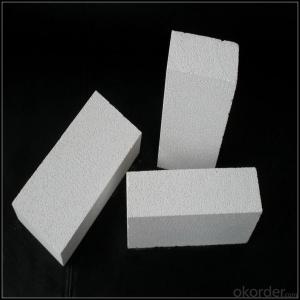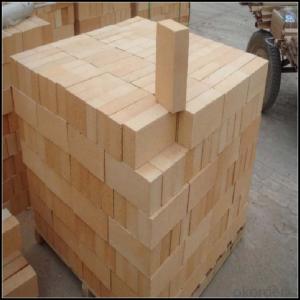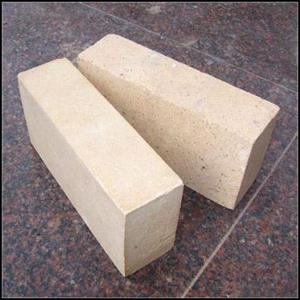Refractory Brick for Furnace Lining/High Alumina Brick
- Loading Port:
- China main port
- Payment Terms:
- TT OR LC
- Min Order Qty:
- 5 m.t
- Supply Capability:
- 800 m.t/month
OKorder Service Pledge
OKorder Financial Service
You Might Also Like
Refractory Brick
CMAX firebricks are classified under temperature between 1300℃ to 1700℃, manufactured from high purity alumina clay by mixing, press-forming, drying, sintering and machining. Bricks contain carefully-graded organic fillers which are burned out during sintering to give a uniform controllable pore structure. This technique makes product feature low thermal conductivity and excellent heat insulation
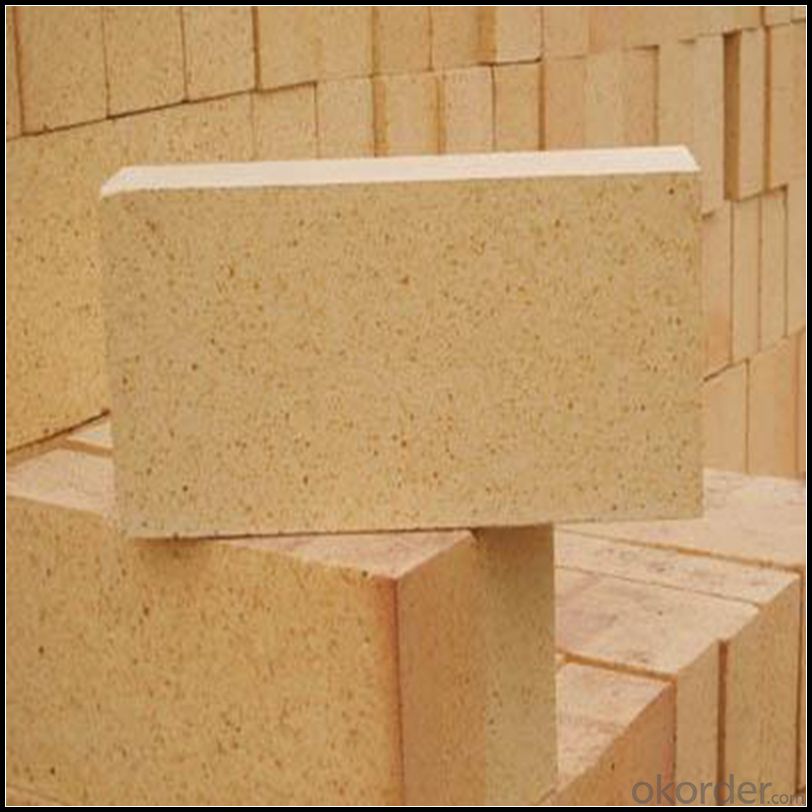
Features
1.Dense crystal structure.
2.High bulk density.
3.High mechanical strength at normal and high temperature.
4.Good thermal shock resistance.
4.Low creep and low permanent liner change rate.
5.High performance of chemical stability and alkaline medium erosion resistance.
Application
1.Building material industry,kiln,heating equipment and the inwall of high—temperature pipe line
2.Chemical industrial high temperature of reaction equipment inwall
3.Power plant ,gas turbine engine and heat insulation of unclear power
4.The fire proof of high—rise building
5.Furnace door of kiln
6.High-temperature filter material
Data Sheet
Classification Temperature (℉/℃) | 3000/1650 |
Bulk Density (g/cm3 ) | ≤1.0 |
Thermal Conductivity | |
800℃, W/m.K | ≤0.39 |
1000℃, W/m.K | ≤0.43 |
1200℃, W/m.K | ≤0.48 |
Reheating Linear Change (%) | 1550℃×12h |
≤0.9 | |
Chemical Composition (%) | |
Al2O3 | ≥75 |
Fe2O3 | ≤0.5 |
Packaging & Shipping
Packaging Details:Be packed in fumigated wooden pallets
Delivery Detail: 30 days after order
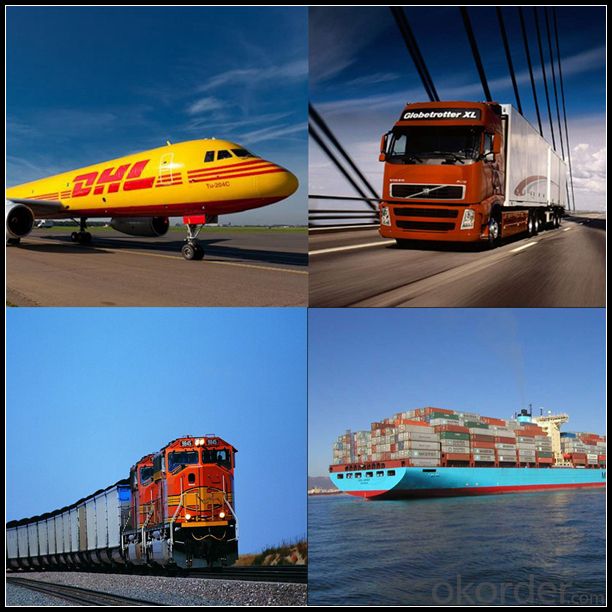
Our Services
Optimum solution and product supply of refractories for high temperature industries, such as iron steel, non-ferrous, petrochemical and building materials.
Engineering design, contract and consult for refractories, and civil architecture design.
Research, development, manufacture and sale of superhard materials.
R&D, manufacture and sale of special packing materials for export.
Inspection, supervision and arbitration of refractories.
Consultation and services in refractories information.
Training and cultivation of high-level talents in refractories profession
Sales Network

Company Information
CNBM (China National Building Material) Group is the largest comprehensive building materials group in China that in integrate scientific research, manufacturing and logistics into one entity. The largest building materials and equipment specialists in China. Upon State Council approval, today CNBM owned more than 300 subordinate manufacturing factories and servicing companies. There are 6 fully owned public listed companies and 11 partially owned with substantial shares public listed companies. In many of these fields, CNBM is playing the leading role in the building industry in the country.
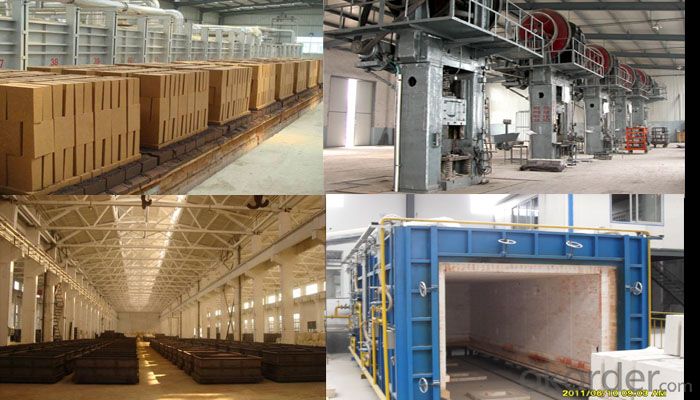
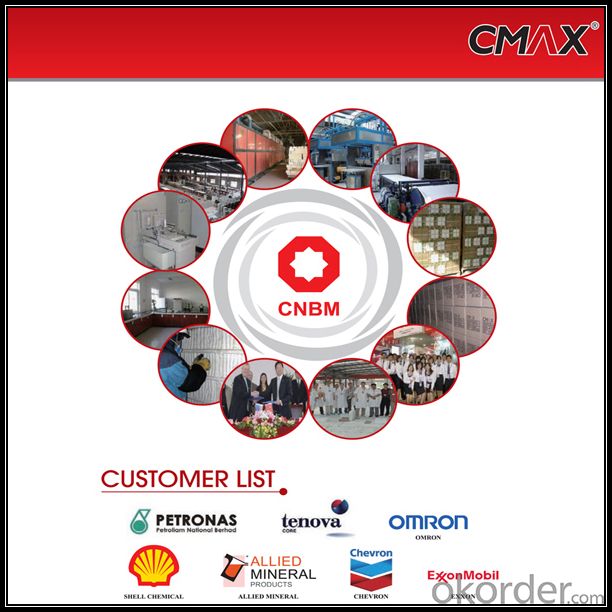
FAQ
1. Which products do you have?
We have all kinds of refractory brick, castable, mortar, cement, ceramic fiber products, etc.
Or you could browse our products to choose what you need.
2. Can you give me a brief introduction of the application of your products?
We are mainly specializing in the refractory materials in iron and steel, cement, glass, ceramics, petrochemical, electric power Industry, etc.
3. If I need your offer, what information do you need?
In order to choose suitable products, it will be appreciated to provide us the information, such us specification, technical data, order quantity, products application etc. If any question, please contact us freely.
- Q:Are insulating fire bricks resistant to spalling?
- Yes, insulating fire bricks are resistant to spalling. Insulating fire bricks are specifically designed to withstand high temperatures and thermal shock, making them highly resistant to spalling. Spalling refers to the cracking and breaking of bricks due to exposure to extreme heat. Insulating fire bricks are made from high-quality refractory materials that have a low thermal conductivity, which helps to reduce the transfer of heat and minimize the risk of spalling. Additionally, insulating fire bricks have a high melting point, which makes them ideal for applications that involve high temperatures. Therefore, insulating fire bricks are commonly used in furnaces, kilns, and other high-temperature environments where spalling is a concern.
- Q:Are insulating fire bricks suitable for use in heat exchangers?
- Depending on the specific requirements and conditions of the heat exchanger application, insulating fire bricks can be considered as a suitable option. These bricks possess exceptional thermal insulation properties, low thermal conductivity, and a remarkable ability to withstand high temperatures. As a result, they effectively minimize heat loss and conserve energy within heat exchanger systems. Moreover, insulating fire bricks are lightweight and possess good mechanical strength, allowing for convenient installation and maintenance. They are also resistant to thermal shock and chemical corrosion, guaranteeing durability and longevity even in harsh operating environments. Nevertheless, it is important to acknowledge that insulating fire bricks may not be appropriate for all heat exchanger applications. In instances where efficient heat transfer necessitates high thermal conductivity, alternative materials with greater thermal conductivity should be taken into consideration, particularly in certain industrial heat exchangers. Ultimately, the suitability of insulating fire bricks in heat exchangers relies on specific factors such as the operating conditions, design requirements, and performance expectations of the system. Therefore, it is advisable to consult experts or engineers well-versed in heat exchanger design and materials to determine the most suitable choice for a particular application.
- Q:Can insulating fire bricks be used in rocket stove designs?
- Yes, insulating fire bricks can be used in rocket stove designs. Insulating fire bricks are specifically designed to withstand high temperatures and provide excellent insulation, making them ideal for rocket stoves which require efficient heat retention. Their lightweight and high insulating properties help to maximize heat transfer and improve the overall performance of the rocket stove.
- Q:Are insulating fire bricks resistant to corrosion?
- Yes, insulating fire bricks are generally resistant to corrosion. Insulating fire bricks are made from high-temperature materials such as alumina, silica, and other refractory materials, which provide excellent resistance to chemical corrosion. These bricks are specifically designed to withstand high temperatures and harsh environments, making them highly resistant to corrosion caused by acids, alkalis, and other corrosive agents. However, it is important to note that the level of corrosion resistance may vary depending on the specific composition and manufacturing process of the insulating fire brick. Therefore, it is advisable to consult the manufacturer or supplier for specific information on the corrosion resistance of a particular insulating fire brick.
- Q:Do insulating fire bricks have a high insulation efficiency?
- Yes, insulating fire bricks have a high insulation efficiency. These types of bricks are specifically designed to provide excellent thermal insulation properties. They are made from lightweight materials with low thermal conductivity, such as various types of refractory clay or alumina. This composition allows them to effectively minimize heat transfer through conduction, making them highly efficient at retaining heat within a structure or appliance. Insulating fire bricks also have a high porosity, which further enhances their insulation capabilities. The presence of numerous small air pockets within the bricks reduces heat transfer by convection, as the air acts as an insulating barrier. This unique structure helps to maintain a consistent and stable temperature, whether it is in a furnace, kiln, or any other high-temperature environment. Furthermore, insulating fire bricks have high resistance to thermal shock, meaning they can withstand rapid changes in temperature without cracking or deteriorating. This property is crucial in applications where temperature fluctuations are common, as it ensures the longevity and effectiveness of the insulation. Overall, insulating fire bricks are known for their high insulation efficiency. They provide excellent thermal insulation, prevent heat loss, and contribute to energy savings. Whether used in industrial settings or residential constructions, these bricks offer reliable insulation performance and contribute to the overall energy efficiency of the system they are employed in.
- Q:Can insulating fire bricks be used in the construction of ladles?
- Yes, insulating fire bricks can be used in the construction of ladles. These bricks are designed to withstand high temperatures and provide excellent thermal insulation. They are commonly used in industrial applications such as ladle lining to maintain heat and prevent heat loss, ensuring efficient and safe operations in metal casting and foundry processes.
- Q:Can insulating fire bricks be used in the construction of pottery slab rollers?
- Yes, insulating fire bricks can be used in the construction of pottery slab rollers. These bricks can provide thermal insulation and withstand high temperatures, making them suitable for pottery kilns and other heat-intensive applications like slab rollers.
- Q:How do insulating fire bricks contribute to energy efficiency?
- Insulating fire bricks possess exceptional thermal resistance, rendering them an invaluable asset in energy-efficient systems. A key contribution of these bricks to energy efficiency lies in their ability to mitigate heat loss. With their low thermal conductivity, insulating fire bricks do not readily conduct heat, making them ideal for insulating areas with high temperatures, such as furnaces, kilns, and fireplaces. By curbing heat loss, insulating fire bricks effectively contain the generated heat within these systems, enabling them to function with enhanced efficiency. Moreover, insulating fire bricks aid in reducing energy consumption. By limiting heat transfer, they necessitate less energy to maintain the desired temperature within a system. This becomes especially significant in industries reliant on high temperatures for operations, as it translates into substantial energy savings. Companies that employ insulating fire bricks can consequently curtail their energy usage, leading to reduced utility bills and a diminished environmental impact. Furthermore, insulating fire bricks contribute to energy efficiency by elevating the overall performance of heating systems. By providing insulation, these bricks ensure a consistent and controlled temperature within the system. This guarantees even distribution of heat and eliminates energy wastage caused by temperature fluctuations. Consequently, systems equipped with insulating fire bricks operate with heightened efficiency and effectiveness. In conclusion, insulating fire bricks play a pivotal role in advancing energy efficiency. Their exceptional thermal resistance properties aid in minimizing heat loss, reducing energy consumption, and optimizing the performance of heating systems. By incorporating insulating fire bricks, individuals and industries can achieve significant energy savings while simultaneously fostering a greener and more sustainable approach to energy consumption.
- Q:Do insulating fire bricks require any curing or drying time?
- Absolutely not! Insulating fire bricks do not need any curing or drying time whatsoever. These bricks are produced through high-temperature methods, resulting in a completely cured and dried product. Consequently, they can be utilized right after installation without any requirement for extra curing or drying time.
- Q:Are insulating fire bricks resistant to acid attack?
- Yes, insulating fire bricks are generally resistant to acid attack. Insulating fire bricks are made from materials that can withstand high temperatures and are designed to provide excellent insulation properties. These bricks are typically made from lightweight refractory materials such as alumina, silica, and other refractory oxides. These materials are known for their resistance to chemical corrosion, including acids. However, it is important to note that the resistance of insulating fire bricks to acid attack can vary depending on the specific composition and manufacturing process of the bricks. Some bricks may have higher resistance to acids compared to others. Therefore, it is recommended to consult the manufacturer or supplier for specific information on the acid resistance of their insulating fire bricks. In general, insulating fire bricks are commonly used in applications where they may come into contact with acids, such as in industrial furnaces, kilns, and other high-temperature environments. They are known for their durability and ability to withstand harsh chemical environments, including exposure to acids. However, it is always important to consider the specific chemical composition and concentration of the acids involved, as well as the temperature conditions, when determining the suitability of insulating fire bricks for a particular application.
1. Manufacturer Overview |
|
|---|---|
| Location | |
| Year Established | |
| Annual Output Value | |
| Main Markets | |
| Company Certifications | |
2. Manufacturer Certificates |
|
|---|---|
| a) Certification Name | |
| Range | |
| Reference | |
| Validity Period | |
3. Manufacturer Capability |
|
|---|---|
| a)Trade Capacity | |
| Nearest Port | |
| Export Percentage | |
| No.of Employees in Trade Department | |
| Language Spoken: | |
| b)Factory Information | |
| Factory Size: | |
| No. of Production Lines | |
| Contract Manufacturing | |
| Product Price Range | |
Send your message to us
Refractory Brick for Furnace Lining/High Alumina Brick
- Loading Port:
- China main port
- Payment Terms:
- TT OR LC
- Min Order Qty:
- 5 m.t
- Supply Capability:
- 800 m.t/month
OKorder Service Pledge
OKorder Financial Service
Similar products
New products
Hot products
Related keywords
